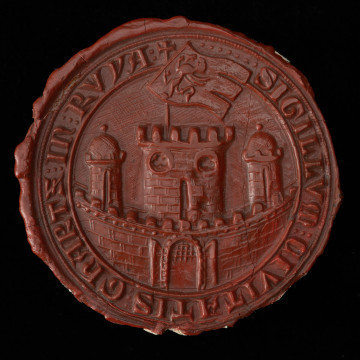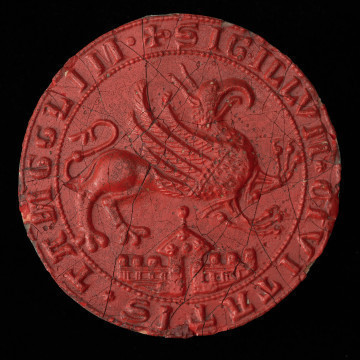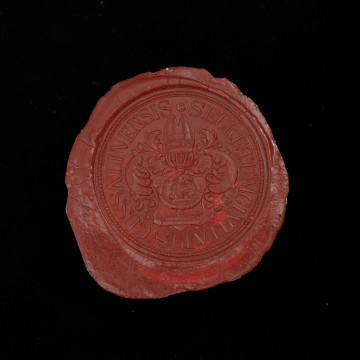
Impression of the municipal seal of Garz
1. połowa XIV wieku
National Museum in Szczecin
Part of the collection: Seals of Pomeranian cities
An imprint of the town seal of Wolgost from ca. 1295 was mentioned by the German graphic artist and herald Otto Hupp (1859-1949) in his publication Die Wappen und Siegel der deutschen Städte, Flecken und Dörfer (Coats of arms and seals of German towns, places and villages). He considers it to be the oldest known seal of the town founded in 1284. The seal field depicts a tower with battlement and a gate, as well as a hoarding – a wooden porch protruding beyond the wall, allowing defenders to strike at attackers from above and from the front. Standing on either side on the battlements are griffins rampant, leaning against the hoarding with their front paws. On the sides of the tower there are keys facing outwards, which resemble the symbol of St. Peter, the patron saint of the Wolgast church. According to the current interpretation, the griffins refer to the Pomeranian dukes, while the tower symbolises a fortified city. The symbolism of the tower, however, is more complex than that. In the early Middle Ages it was reserved for the sovereign and his fiefs. Although in the 13th century rulers moved to castles and the tower became an element of city fortifications; however, in social consciousness it still functioned as an attribute of power and high status of the inhabitant. The tower in the municipal coat of arms thus stands for self-government and freedom of the rich burghers, who wanted political independence. The coat of arms has been modified over the centuries. In the 14th century, the tower and only briefly disappeared, replaced by the griffin with the keys. The contemporary municipal coat of arms, designed at the end of the 19th century, resembles the coat of arms from the seal made in 1295, although a few changes have been introduced. The roof of the tower was given the shape of a dome, the entrance hole was closed with a door and griffins were set on the bits of the keys, which now rest on the ground.
Mieszko Pawłowski
Other names
Siegel
Author / creator
Dimensions
cały obiekt:
Object type
seal
Technique
impressing
Material
wax
Creation time / dating
Creation / finding place
Owner
National Museum in Szczecin
Identification number
Location / status

1. połowa XIV wieku
National Museum in Szczecin

1284
National Museum in Szczecin

1. połowa XIX wieku
National Museum in Szczecin
DISCOVER this TOPIC
Castle Museum in Łańcut
DISCOVER this PATH
Educational path